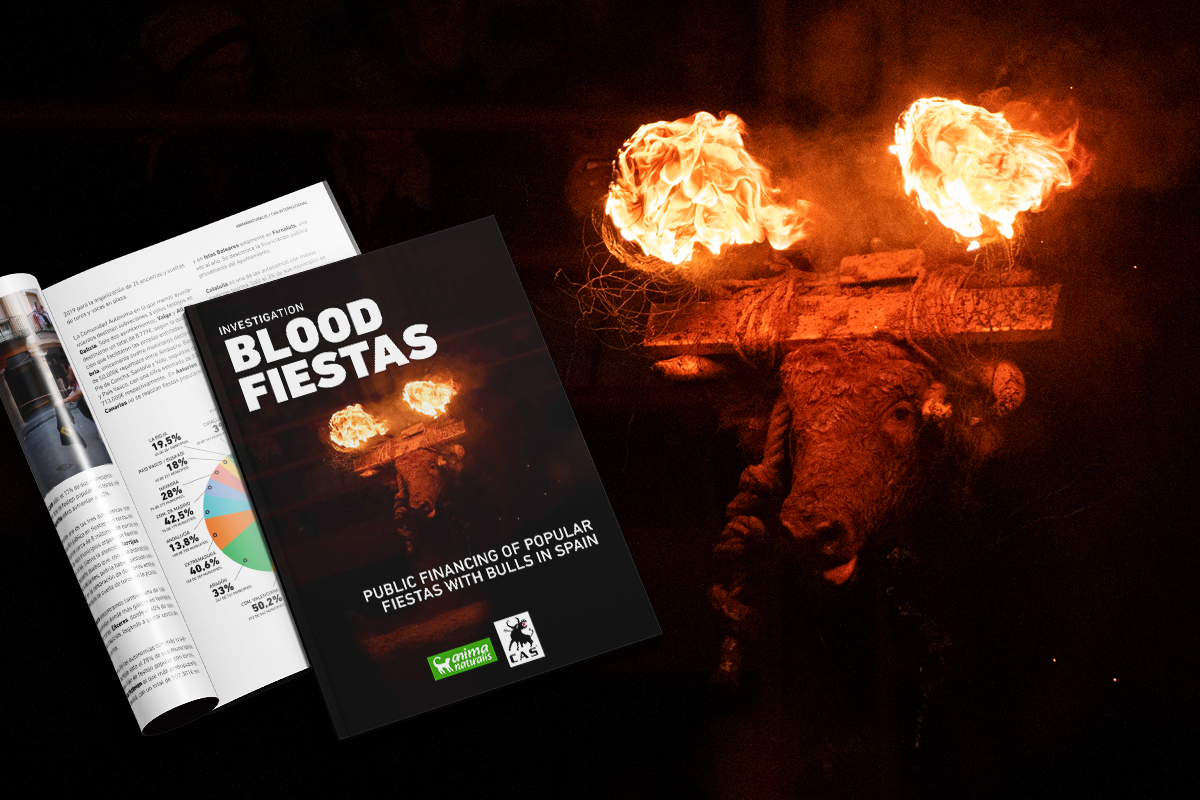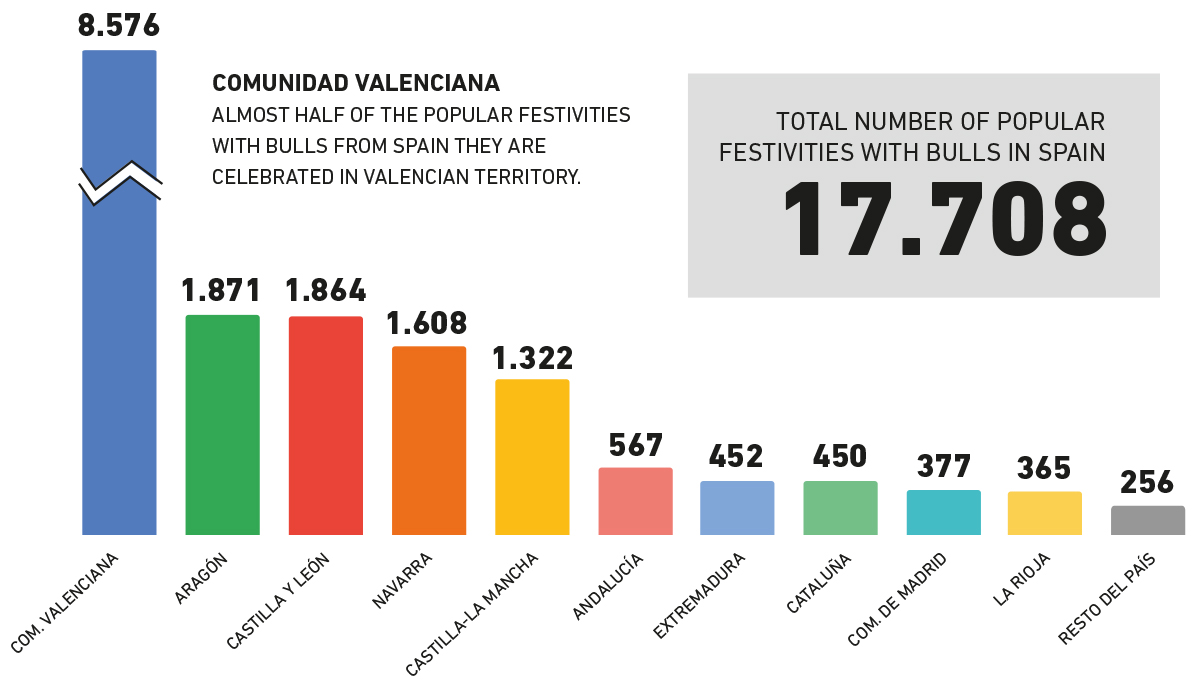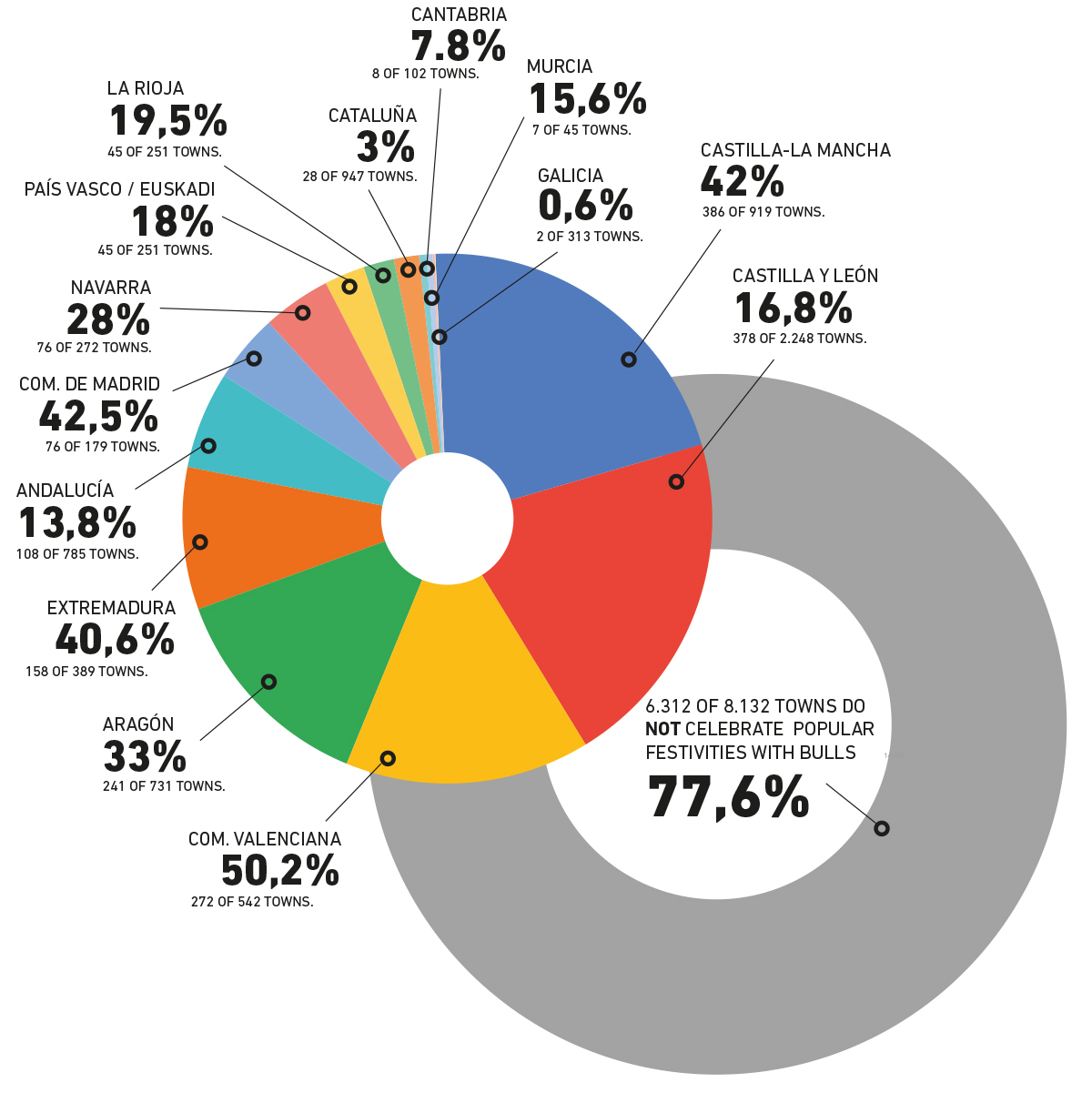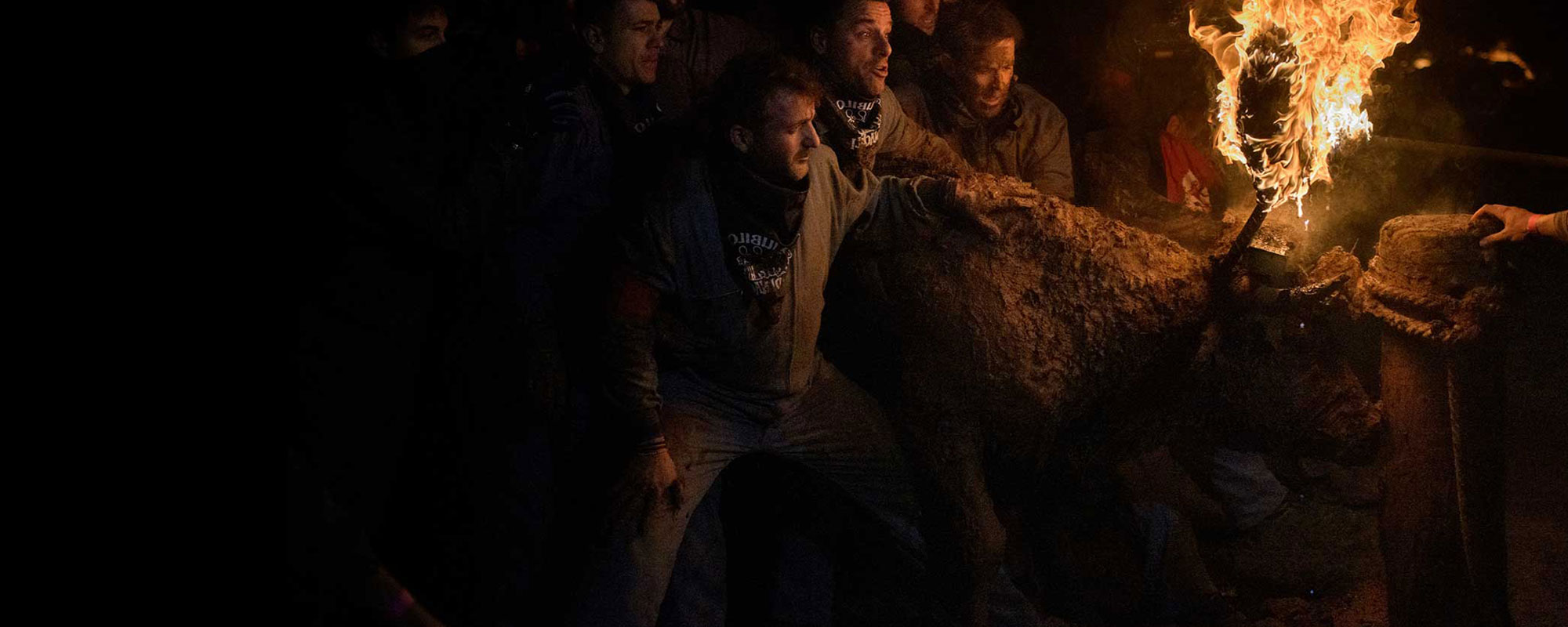AnimaNaturalis and CAS International have conducted an intensive investigation in all municipalities in Spain to discover how much public money is allocated to maintain and subsidize popular bull festivals. Based on transparency laws, through the electronic headquarters of each municipality's website, each one of the 1,820 municipalities that organize popular bull festivals were contacted. The estimated figure amounts to a total of 42 million euros in 2019, covering the organization of a total of 17,708 festivals. This figure remains more or less stable year after year in most municipalities, although some have already doubled it in 2023, as is the case with the Fuenlabrada City Council in Madrid.
In total, 1,820 municipalities organize some type of popular bull festival every year. This represents 22% of all municipalities in Spain. Despite the law requiring transparency in the allocation of public funds by each municipality, only 47% of the contacted councils responded within the specified deadlines set by Law 19/2013. Even after appealing to higher authorities and lodging formal protests, the rest have not responded.
During the course of the investigation, we discovered that municipalities are funding expenses directly and indirectly through at least three possible avenues: directly from the municipal budget for festivals, through subsidies to bullfighting clubs, which often organize and manage the festivals, or through agreements with associations or companies in which the entire organization of major or patronal festivals, which also include bull-related events, is delegated. Some municipalities recover part of the investment by selling boxes or charging admission, but this only happens in some festivals and municipalities.
Therefore, we regret the fact that it is practically impossible to know the real amount of public money allocated to the organization of these types of festivals, but we estimate that it cannot be less than 42 million euros, and the total cost of these festivals amounts to 86 million euros. Therefore, the actual amount of public money allocated to popular bull festivals falls within that range.
The difference of figures between the Ministry of Culture and regional administrations
During the investigation, we found a problem with the figures provided by regional and provincial administrations and those provided by the Ministry of Culture, responsible for collecting all the data.
According to the Statistics of Bull-related Matters prepared by the Division of Statistics and Studies, Technical General Secretariat of the Ministry of Culture and Sports, these are the figures they published for 2019:
From the 8,623 shows in the Valencian Community in 2019, we move to 1,946 in Castilla y León, 1,591 in Navarra, 1,250 in Castilla-La Mancha, 1,079 in Aragón, 711 in the Community of Madrid, 559 in Extremadura, 373 in Andalusia, 303 in La Rioja, 170 in the Basque Country, 66 in Catalonia, 61 in the Region of Murcia, 25 in Cantabria, and 1 in Galicia.
However, these figures do not match the ones provided by regional and provincial administrations. For example, the Government of Catalonia reported that in 2019, 450 bull-related events were organized, not the 66 reflected by the Ministry of Culture. In our investigation in Galicia, we identified at least 19 popular bull festivals, distributed over 10 days and in two municipalities, but only 1 is recorded by the Ministry of Culture. In the case of Aragón, the Ministry of Culture announced 1,079 festivals, but in our investigation, we counted up to 1,871.
Figure 1: Distribution of popular festivals with bulls in Spain
The findings of the investigation
The municipalities in the Valencian Community allocate the most public money for organizing bull-related festivals. In 2019, we estimated that its municipalities spent a total of 17 million euros, a figure that triples the next autonomous community with the highest estimated expenditure, Castilla y León, with nearly 6 million euros.
The Valencian Community has by far the highest concentration of annual bull events. In 2019, 8,623 shows took place, including "bous al carrer" (bull runs), "toros embolados" (bulls with fire on their horns), "toros ensogados" (bulls with ropes), or "toros a la mar" (bulls in the sea). In fact, 50% of all Valencian municipalities organize some type of bull event every year, a much higher percentage than its neighbor Catalonia, where only 3% of its municipalities organize bull-related events.
Castellón is the province that allocates the most public investment to bull events, with 94% of its municipalities actively involved in organizing and financing bull-related festivals. Vall d'Alba, Cabanes, and Vila-Real are the three municipalities that celebrate the most events and invest the most money in them.
In the province of Valencia, 41% of its municipalities have a municipal budget for bull-related events, with Puçol, Lliria, Sagunto, Alcàsser, and El Puig de Santa María being the municipalities that most strongly support "bous al carrer" (bull run) events.
In comparative terms, the province of Alicante has the least bull-related tradition, with only 26% of its municipalities organizing events. Xabia and Pedreguer are the municipalities where "bous al carrer" events are most prominent, with an estimated expenditure of around 440,000 euros for approximately 40 events in each municipality.
The Community of Madrid, along with the Valencian Community, has one of the highest percentages of municipalities with popular bull events. Specifically, 42% organized some type of event in 2019, often as a prelude to major bullfighting spectacles such as bullfights, novilladas, or becerradas. However, the Community of Madrid lags far behind Castilla y León, Castilla-La Mancha, Navarra, or Aragón in terms of the total number of events. Nevertheless, this community is home to two municipalities that have reported the highest public investment in popular bull festivals in 2019: Fuenlabrada (€158,090.30) and Navacerrada (€89,703.13). In the case of Fuenlabrada, the budget has already been doubled for 2023.
Figure 2: Towns of Spain that celebrate popular traditions with bulls
Castilla y León and Castilla-La Mancha are two regions with a high number of bull events and a significant municipal budget for their organization. They are the regions that concentrate the highest number of municipalities that spend the most per capita, especially in municipalities with fewer than 1,000 inhabitants. In Castilla y León, 17% of its municipalities have popular bull events, while in Castilla-La Mancha, it is 42%.
Aragón is one of the three autonomous communities with the highest public funding for bull events, with nearly 8 million euros invested in 2019. 33% of its municipalities organize these events, with Torrijas (Teruel) being noteworthy. This small town, with a population of only 38 inhabitants, is estimated to have spent nearly €27,000 on organizing two "toros embolados" events and two bull releases in the square.
In Extremadura, we also find one of the Spanish provinces that spend the most on popular bull festivals: Cáceres, where 40% of its municipalities are involved, spending nearly 2 million euros.
Navarra is one of the autonomous communities with a strong bullfighting tradition, although only 28% of its municipalities organize some type of event, with Peralta/Azkoien being the municipality that allocated the most municipal budget, with a total of €107,301.
The autonomous communities with the fewest municipalities allocating public money to these events are Galicia, where only two municipalities, Valga and Allariz, allocated a total of €8,779.77, according to the information provided by the municipalities themselves. In Cantabria, only four municipalities allocated around €50,000, followed by Catalonia and the Basque Country, with an estimated figure of €832,000 and €713,000, respectively. In Asturias and the Canary Islands, these types of events are not held, and in the Balearic Islands, only in Fornalutx, once a year.
Catalonia is one of the autonomous communities with less bullfighting tradition. Only 3% of its municipalities are involved in organizing bull-related events, with the majority concentrated in the province of Tarragona, in areas bordering Castellón and Teruel. The municipality with the highest per capita expenditure is Alfara de Carles, which allocated €39,000 to organize 11 events for a population of only 376 inhabitants. The municipality that spent the most on "correbous" events was La Ràpita, with a total of €68,658.60.
The Basque Country stands out for being one of the autonomous communities with fewer popular bull events and less public expenditure on this activity. Only 18% of Basque municipalities celebrate popular bull events. Despite having more municipalities with a bullfighting tradition than Catalonia, the number of events was a third less: 155 according to our investigation (170 according to the Ministry of Culture). Biscay is the province with the strongest bullfighting tradition, followed by Gipuzkoa and, lastly, Álava. Azpeitia is the municipality with the most events.
The Region of Murcia is one of the autonomous communities with fewer popular events: 61 spread across seven municipalities.
Figure 3: Distribution of public money given to popular traditions with bulls in Spain
Municipalities with fewer than 100 inhabitants that spend the most on bulls
During the investigation, we identified numerous towns with fewer than 100 inhabitants that allocate a significant amount of public money to organize bull events, much higher than the Spanish average per capita, considering the population.
In these cases, there is nothing that can justify such economic investment, other than pressure from bullfighting entities since these towns do not have businesses, restaurants, or other hospitality services, making it difficult to justify these events as a means of attracting tourism.
According to the responses we received from municipalities, Castilla-La Mancha and Castilla y León are the autonomous communities that concentrate the most towns with disproportionate public spending on bulls. The municipality that spent the most on bulls per capita was Fuentelviejo, in Guadalajara, which allocated a total of €12,934.20 for three "encierros por el campo" (rural bull runs) for a population of only 54 inhabitants, which amounts to €239.52 per inhabitant. Also in Guadalajara, the second municipality that spent the most on bulls in Spain is Zorita de los Canes, which, with a population of 63 inhabitants, allocated €13,606.45 to organize a bull run.
Aragón also has numerous small municipalities with a high budget for popular bull events. This is the case with El Castellar (Teruel), with a population of 56 inhabitants and a total expenditure of €12,000 for a total of 6 events, especially fire bulls or "toros embolados". The per capita expenditure was €214.29. Another example would be Cañada de Benatanduz, which allocated €4,686.50 in 2019 to organize a bull run and two "toros embolados" events for a population of only 34 inhabitants.
In the province of Castellón, even without official data that have not been provided, it is estimated that there is the highest proportion of towns with an extremely high expenditure per inhabitant, such as Pina de Montalgrao, where with a population of only 114 people, at least 24 bull events are organized, costing around €93,000.






